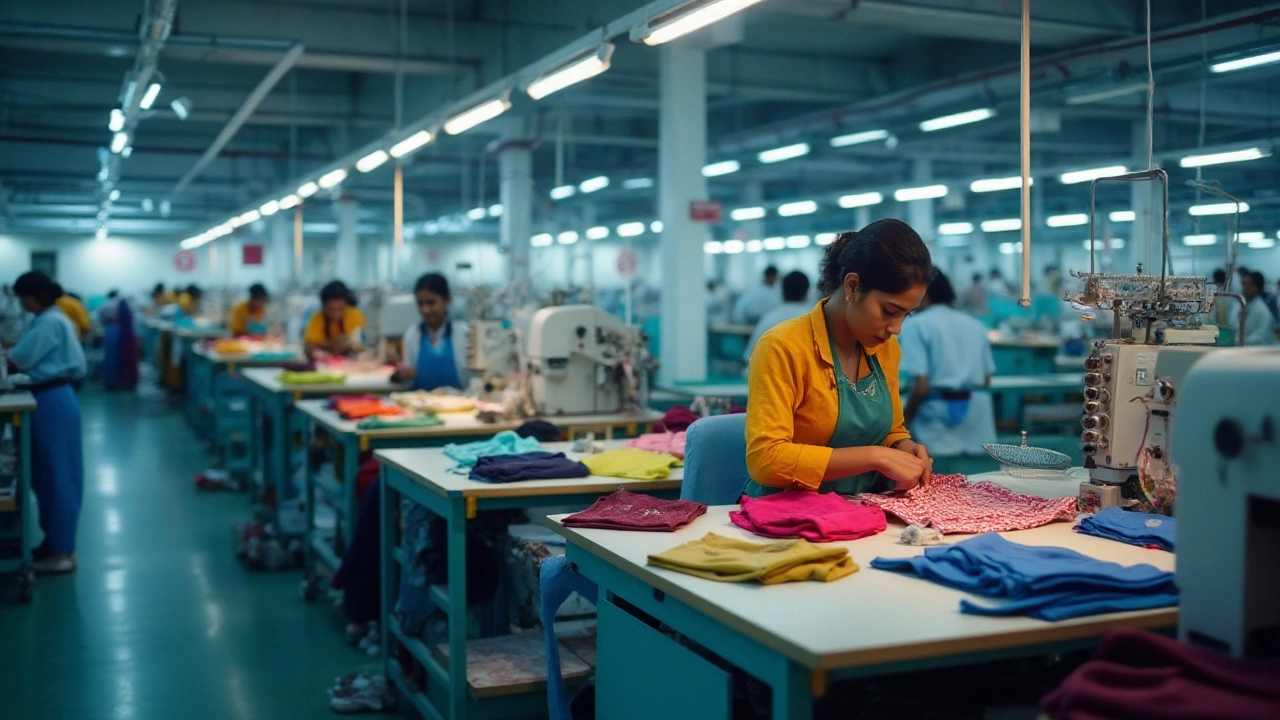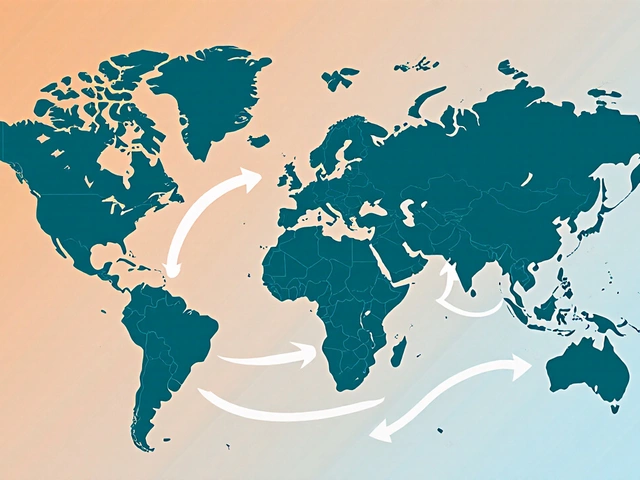The garment industry is a bustling sea of fabric, threads, and commerce that weaves countries together through trade. At the heart of it all is the United States, a major market with immense demand for apparel and textiles. The numbers from 2024 reveal intriguing insights into which nations are sending the most garments across the Atlantic.
The spotlight often shines on Asian giants such as China, Bangladesh, and Vietnam, but there's more to the story. India, with its rich textile heritage and competitive manufacturing, plays a significant role in this export narrative, though it faces competition from its neighbors. Other emerging players are also stepping up, making their presence felt in American stores.
To understand why certain countries lead, it's essential to look at their unique strategies and infrastructure that support large-scale production. Political stability, trade agreements, and innovation in sustainable practices all influence these rankings. As we delve into these topics, it becomes clear how interconnected and competitive the world of textiles is today.
- Current Landscape of Garment Exports to the USA
- Role of India in Textile Exportation
- Top Garment-Exporting Countries to the USA
- Strategies Behind Successful Exports
- Future Trends in Textile Trade
Current Landscape of Garment Exports to the USA
The complex world of garment exports to the USA is a vivid tapestry of economic strategies, trade relationships, and cultural exchanges. As of 2024, the USA has remained one of the largest importers of apparel globally, drawing in garments from a diverse array of countries. The pulsating heart of the garment export industry thrives on the dynamics between demand in the United States and the intense supply capabilities of exporting countries.
China continues to dominate the garment export scene with its massive production capacity and well-established supply chains. However, there is a noticeable shift happening. Countries like Bangladesh and Vietnam have carved significant slices of the American market. This shift often comes from these nations' ability to offer a mix of competitive pricing, favorable trade agreements, and robust manufacturing infrastructure. Data from recent years highlight that the garments exported from these countries form a substantial percentage of USA imports, with an emphasis on both quality and affordability. In fact, recent statistics suggest China's share has been diversifying, reflecting a broader trend towards multi-source import strategies by American companies.
Interestingly, India remains a noteworthy player aiming to expand its foothold in the USA. The Indian textile sector, buoyed by traditional craftsmanship and modern technological advancements, continues to produce a wide variety of high-demand products. Indian manufacturers emphasize strength in producing traditional as well as contemporary apparel, catering to niche markets seeking unique styles and sustainable practices. The role of South Asia, including India, is underscored by trade policies and strategic partnerships that cater to shifting consumer preferences, especially towards eco-friendly and ethically produced clothing.
Market Diversification
The US market has seen a diversification not only in terms of countries but also in product types. From basic apparel to high-fashion garments, the spectrum is wide. It's not just about bulk anymore; it's increasingly about quality, sustainability, and design innovation. Businesses in countries exporting to the USA are continually upgrading their operations to meet these evolving demands. For instance, automation and smart technologies are seeping into factories, redefining timelines and precision in production.Emerging markets are also starting to leave their mark. Smaller countries, recognized for specific apparel types or techniques, such as Cambodia or the nations within Africa, are challenging traditional perceptions. These newcomers to the scene are often supported by initiatives seeking to create sustainable and diverse sourcing options. One trade analyst noted, "As consumers become more conscious about the making of their clothes, the origin becomes as significant as the brand."
Challenges in the Export Landscape
However, navigating this landscape isn't without its challenges. Tariffs, geopolitical tensions, and fluctuating economic policies continuously test the resilience of trade routes. Manufacturers must be adaptable, often engaging in scenario planning and risk management to maintain their competitive edge. In table format, we've noted the top five countries exporting garments to the USA along with their respective export values in billions for 2024:| Country | Export Value (in billions USD) |
|---|---|
| China | 33 |
| Bangladesh | 9.5 |
| Vietnam | 12 |
| India | 8 |
| Indonesia | 7 |
This table signals a diversified import strategy by the USA, showing reliance on multiple markets for meeting its immense apparel needs. As these trends continue to develop, the landscape of garment exports to the USA will likely become even more intricate, leading to a fascinating evolution of the trade system.
Role of India in Textile Exportation
India has carved out a significant niche for itself in the world of garment exports, standing tall alongside other Asian powerhouses in the global textile trade. With its rich history steeped in textile craftsmanship, India possesses a unique advantage. The country harnesses its vast but skilled labor force and abundant raw materials to produce textiles that are both diverse and high-quality. This heritage is not merely a relic of the past; it actively influences India's present-day industry, which adapts traditional techniques for modern markets. Major Indian cities like Mumbai, New Delhi, and Bengaluru are transforming their manufacturing hubs into state-of-the-art facilities that can churn out millions of garments annually. The combination of tradition and innovation sets India apart as a formidable player in textile exportation.
India's role in textile exportation is also bolstered by government initiatives aimed at boosting production and exports. The 'Make in India' campaign, along with state-specific policies, provides incentives such as tax benefits and loosening of regulations for textile manufacturers. These efforts are designed to make Indian textile companies more competitive on the international stage, especially in the coveted American market. Moreover, Indian manufacturers have been increasingly focusing on sustainable and eco-friendly production practices, responding to the growing global demand for ethical and sustainable fashion.
Trade agreements play a pivotal role in shaping India's textile export landscape. With longstanding trade relations with the United States, India benefits from relatively low tariffs on specified apparel categories. This advantage enables Indian garments to enter the U.S. market at more competitive price points compared to some other origin countries. The rapport between the nations ensures a steady flow of trade, fostering economic ties that are mutually beneficial. India's textile exports to the US have also been augmented by digital platforms that open new channels for Indian garments to reach American consumers directly and efficiently.
In 2024, India exports a substantial volume of textiles to the United States, standing as a testament to the robust upgrades in both technology and infrastructure that support this level of international trade. India's apparel manufacturers have had to become adept at navigating the complexities of compliance with U.S. safety and quality standards. As they do, these businesses continually innovate and refine their operations to meet ever-evolving consumer demands. An interesting fact to note is that sectors such as home textiles, like bed linens and towels, have prominently risen within India's exports, underlining the versatility of its textile industry.
According to the Ministry of Textiles, India is set to reach a textile export target of $100 billion by 2025, and this ambition isn't unfounded. The scope of India's textile industry is vast, anda textile manufacturers are performing excellently, from traditional handloom weaving communities to advanced fabric dyeing and processing plants. This growth trajectory is being closely watched by market analysts and competitors worldwide. There's a profound sense of optimism in the air regarding India's potential to scale new heights, fueled by the country's youthful demographic and their eagerness to imbibe new skills.
Noteworthy here is a comment from Sunil Sethi, Chairman of the Fashion Design Council of India:
"India is not just exporting garments; we are exporting stories, colors, and cultures. Every piece carries with it centuries of artistry and it is this intrinsic value that resonates with consumers worldwide."India’s textile industry is indeed a tapestry of collaboration, innovation, and visionary goals that ensure its products find favor in markets throughout the globe.

Top Garment-Exporting Countries to the USA
In the bustling global village that is the garment industry, several countries have etched their names at the forefront of garment exports to the USA. The landscape is dynamic, driven by economic, geographic, and political nuances, and has been vividly painted by the likes of China, Vietnam, Bangladesh, and, increasingly, India. China remains a colossal player, its dominance akin to the Great Wall—an enduring symbol of strength in the textile realm. With its robust infrastructure and competitive pricing, China continues to meet the extensive demands of American retailers.
Vietnam, riding a wave of stable economic policies and strategic trade agreements, has secured its place as a top exporter. The country’s focus on sustainable fashion and high-quality production appeals significantly to the US market, which increasingly values ethical consumerism. Interestingly, Bangladesh, with its expansive garment production capacities, harnesses its vast pool of skilled labor to compete fiercely, offering fashionable yet cost-effective clothing options.
Meanwhile, India, a country with deep-rooted textile traditions, is making notable strides. As an emerging leader, India leverages its diverse range of fabrics and vibrant designs to attract USA imports. The Indian garment industry, supported by government initiatives and a youthful workforce, poses a growing challenge to its rivals. "India is not just an exporter; it's a storyteller with every garment," says Ritu Kumar, a renowned Indian designer, emphasizing the unique value proposition that Indian textiles bring to the American consumer.
According to recent data, the US garment import volumes have transformed significantly. Here's a glimpse of the latest figures:
| Country | Export Value (USD Billion) |
|---|---|
| China | 27.4 |
| Vietnam | 16.8 |
| Bangladesh | 10.2 |
| India | 8.5 |
Governments play a pivotal role in shaping the global trade of textiles through policies and trade agreements that either elevate or restrain exports. For instance, the US-China trade tensions have sometimes tipped the scales, directing businesses to hedge their sourcing strategies towards Vietnam and Bangladesh, renowned for their stability and favorable trade terms. As American consumers increasingly seek diversified options, these shifts encourage countries like India to adapt rapidly to changing market trends.
The trends in textile manufacturers reflect a world that is progressively moving towards sustainable and ethically-produced garments. Countries that adapt to these changes are likely to maintain or increase their foothold in the US market. In this competitive arena, staying relevant goes beyond mass production. It's about innovation, ethical practices, and the ability to tell a story through every stitch and seam.
Strategies Behind Successful Exports
When it comes to dominating the garment exports market, some countries have developed a clear playbook that they follow to ensure success. At the core of these strategies is the adaptation to ever-shifting global demands and consumer preferences. Countries like China, Vietnam, and Bangladesh often top the list due to their robust infrastructure and policies favoring mass production. They have cultivated ecosystems which support textile industries, from raw material suppliers to state-of-the-art manufacturing facilities.
Such a system allows them to produce clothing at a competitive price while maintaining quality. Primarily, these nations utilize economies of scale to minimize production costs. This factor is closely tied with having a skilled labor force that can efficiently handle complex manufacturing processes. For instance, Bangladesh has invested heavily in training and upskilling its workforce, thereby improving both productivity and quality of their exports. It's not uncommon to see a country like Bangladesh export garments at a lower cost yet with standards that match those in upscale markets. A focus on sustainability is another significant strategy seen among these leading exporter nations. As the global push towards eco-friendly practices intensifies, textile producers in India and Vietnam have pioneered innovations in sustainable fabric production, thereby enhancing their appeal to environmentally conscious consumers.
The alignment of trade policies and establishing beneficial trade agreements also plays a crucial role in capitalizing on opportunities within international markets. Vietnam's participation in the Comprehensive and Progressive Agreement for Trans-Pacific Partnership (CPTPP) illustrates how strategic partnerships open up new markets by reducing tariffs and easing trade barriers. These trade agreements cut costs significantly for importers in the USA, making garments from member countries more attractive compared to non-member suppliers. Another crucial strategic maneuver is the diversification of product lines to meet varying seasonal demands and stylistic preferences. Chinese manufacturers, in particular, excel here by offering an extensive range of products spanning from basic everyday wear to high-fashion items. They continuously keep a finger on the pulse of fashion trends to ensure their exports match the tastes of consumers in the USA.
Marketing and brand positioning hold great importance as well. Even the best products require a robust marketing strategy to penetrate and sustain in global markets. E-commerce has become an indispensable tool, greatly enhancing the reach of exporters into the USA. Many are now partnering with major online platforms or setting up direct-to-consumer sites to streamline their operations. Leveraging technology to streamline production processes, logistics, and inventory management has further cemented the ability of these countries to dominate the market. According to data from the World Trade Organization, in 2023, approximately 60% of the apparel exported to the USA came from these top strategic players. This figure underscores the effectiveness of employing a combination of innovation, policy, and foresight.
Reflecting on these strategies showcases the necessity of being agile and forward-thinking. An ability to pivot and realign with global trends is what sets these exporting countries apart, allowing them to satisfy the constantly evolving demands of the USA imports market. As the industry grows, these strategies will continue to define successful participation in garment exports.

Future Trends in Textile Trade
As we stand on the cusp of innovations, the textile trade is poised for transformative shifts that could redefine its landscape for years to come. One noticeable trend is the growing inclination towards sustainability, as consumers and manufacturers alike become more environmentally conscious. Brands are actively seeking ways to minimize carbon footprint, and this extends to sourcing materials. The focus on eco-friendly production processes is not just a fad but a necessary response to climate change pressures. This shift is sparking demand for organically sourced fabrics and recycled materials, offering new avenues for textile manufacturers in India and beyond.
The evolution of technology is another compelling force driving this sector. Many are predicting that digital transformations like AI and IoT will revolutionize garment production and supply chain management. Companies are leveraging these technologies to streamline operations, enhance quality control, and predict consumer trends with increased accuracy. A remarkable example is Adidas, which has experimented with local, on-demand manufacturing at its Speedfactory to reduce lead times and increase agility. This shift towards technology-driven manufacturing hints at a future where digital innovation is integral to maintaining a competitive edge in garment exports.
"The textile industry is undergoing a significant shift, moving from being heavily reliant on human skills to capitalizing on data-driven decisions and AI," says Fiona Brady, a textile analyst at Greenstripes Solutions.
Trade policies and international relations still hold substantial sway over textile exports but the emerging trends in geopolitics could lead to more regional trade blocs rather than reliance on traditional markets. Given the geopolitical uncertainties, countries are seeking to enhance intra-Asia trade or diversify their markets beyond established giants like the USA. This could open up new opportunities for smaller economies to increase their USA imports capacities by building robust intra-regional ties.
The rise of ethical consumerism cannot be overlooked either. Consumers are demanding transparency, and they wish to know the origins of the clothes they wear, the people who make them, and the conditions under which they're manufactured. This demand is pushing brands towards more transparent supply chains. Blockchain technology, for instance, is being explored as a means to provide irrefutable proof of a product's journey from raw material to retail, a move that's set to redefine consumer trust and brand loyalty.
While change is indeed on the horizon, the core of the textile trade remains its ability to adapt and evolve. As the narrative unfolds, one thing is clear: those who can navigate these emerging trends successfully will not only thrive but will drive the next wave of innovation in the global textile industry. With shifts in consumer behavior, technology, and geopolitics, the future promises a dynamically fluid textile landscape.











Write a comment